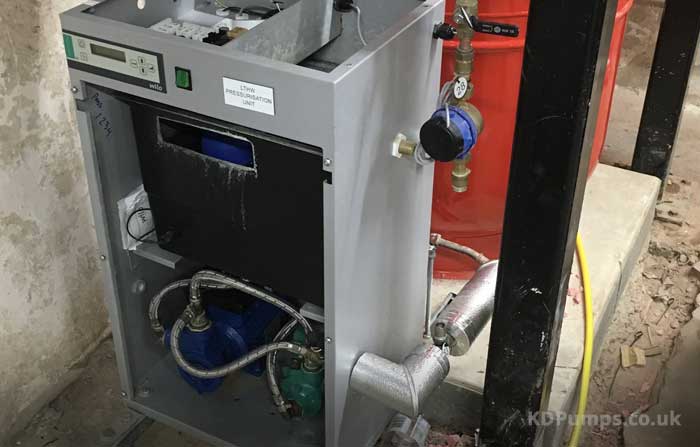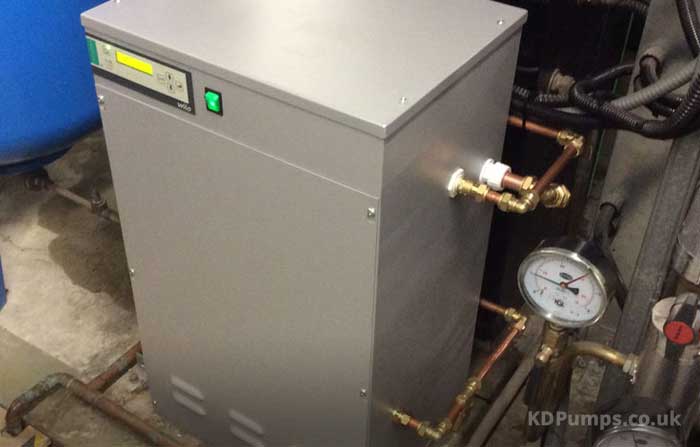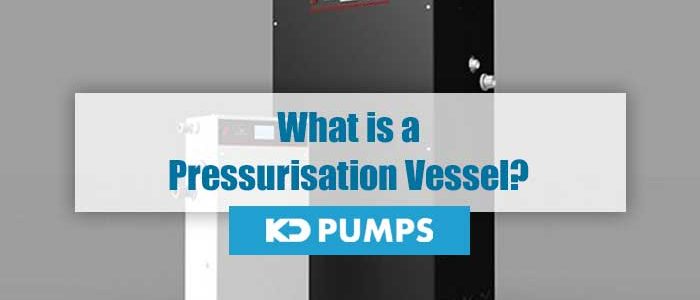What is a Pressurisation Vessel?
A pressurisation unit, or PU, is a piece of equipment used to pressurise a system.
Basically, it fills the system to an optimal pressure level to achieve the best flow.
Either one or two peripheral pumps are used to maintain the required pressure in the system, and pressure switches control this as they can sense the pressure in the system.
This is in a nutshell what a pressurisation vessel is.
But to help you understand what such a pressurisation system entails, we will delve a bit more into how it works and how you can choose the best type for your needs.
Article Chapters
What is a Pressurisation Vessel?
Heating pumps or hot and cold water services require a pressurisation unit to ensure the best flow.
When pressure is lost or in cases when it falls below the optimal level, the pressurisation unit will detect this and engage the pumps accordingly.
The pressurisation unit is linked to a closed system at a neutral point, which is not impacted by the system pump.
Pressurisation units may eliminate the need to have a cold water storage system on the roof, and they are ideal in cases when a header tank cannot be fitted.
How Does a Pressurisation Vessel Work?

A pressurisation vessel is a mechanical way of pressurising a system involving hot and cold water services.
Such a system will include operating pressure switches, and in some systems there are also high and low pressure interlock switches.
These will detect the system pressure and the pumps will then work accordingly, depending on the level of pressure.
There are different types of pressurisation vessels which we shall delineate in more detail below.
Open Systems vs Pressurisation Units
An open system, or a chiller system, as it is sometimes referred to, will have its feed and expansion tank above the highest point within the system.
This will feed it with water, as well as ensure that there is a proper accommodation for any losses resulting from evaporation.
This arrangement will lead to air to be absorbed in the water.
In turn this results in corrosion of heat exchangers, and possibly even the pipes and boilers.
On the other hand, with a sealed system there will be a limit on the air intake, and corrosion will be limited as a result.
In such a case, only fresh water will be used to make up for any losses resulting from leakages.
Moreover, with the higher flow temperatures used in such a sealed system, there will be lower water circulation rates.
Additionally smaller pumps and pipework will be needed, resulting in cost savings.
Since traditional systems are open, air is able to make its way into the system.
This is the main problem with such a system.
This is why pressurisation sets were introduced over the years, as they can help to resolve such issues.
Pressurisation sets are enclosed, and so the air is not able to enter the system.
Hence it will neither contaminate the unit nor cause any problems relating to oxidisation.
Moreover, with such pressurisation sets, you will have a more compact system.
There is no risk of storing water in a heavy structure situated at a high level, and so unlike an open system, there will not be a lot of unnecessary use of space or the need for proper structural support.
A heating or cooling system will benefit from a pressurisation set because their compactness, and sealed arrangement are great advantages when compared to an open system.
Selecting the Best Pressurisation Unit

Now that you have a good idea of the types of pressurisation systems, you are also aware of their respective pros and cons.
If you are currently trying to decide on the best pressurisation unit you should bear these in mind.
However, there are also important factors to take into account when a pressurisation unit is being sized.
First of all, you will need to work out the static head of the system.
This is calculated by counting the number of floors in the building and multiplying this by 3 metres.
Then, add 0.5 Bar on top so as to ensure that the top floors are always pressurised.
Pressures are measured in scales: 1 Bar = 10m.
Hence, in the case of a building with 10 floors and a basement you will have 11 multiplied by 3m.
The result is 3.3 Bar, and you will then need to add 0.5 Bar to it.
Hence the static pressure in this case would amount to 3.8 Bar.
Therefore you will need a pressurisation unit that has a fill pressure of 3.8 Bar.
The vessels on a pressurisation system are sized from the expansion factor.
The content will need to be used along with the heat or cooling power, as well as the static head of the system.
In the case of a heating system located on the roof of a building, there are going to be smaller vessels than in the case of a system situated in a basement.
This is because the static head will be considerably smaller.
Also, in the case of the vessels on a chilled water system, there won’t be large vessels since they will only need to handle expansion when the chiller is switched off.
It is important for the vessels in a pressurisation system to be sized well to ensure they will suit the required applications.
Where to Install Your Pressurisation Vessel
A pressurisation vessel needs to be installed by a professional to ensure that it can operate efficiently.
This is even more important in the case of large buildings or business establishments, where such a system could affect productivity, and also lead to wastage in case there are leakages or improper pressure levels.
Hence pressurisation vessels are of the essence especially in the case of hotels, manufacturing companies, prisons, schools etc.
Pressurisation vessels are designed to offer a replacement for water that is lost through the system due to leakages, as well as to maintain the filling pressure in the system at the best possible level.
Such a system will also offer peace of mind since in case the boiler or chiller unit are going to be damaged as a result of extreme pressure levels, there are safety circuits in the system which will prevent this from occurring.
Conclusion
A pressurisation system can offer you various advantages.
As discussed above, there are different options, and it is important to consider the various factors to choose the best system for your needs.
The proper choice and installation of a pressurisation set is important to enable you to get the most out of it.
And as with any other system, regular maintenance is also very important.


Comments are closed.